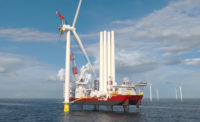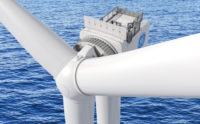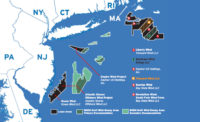Wind Installation Bottleneck Threatens 23% of US Projects

As land-based wind turbine blades get longer, the need for specialized transportation increase.
PHOTO: COURTESY OF VESTAS
The logistics of getting land-based wind turbines to project sites could create a bottleneck over the next two years, potentially delaying or canceling up to 23% of all installations and putting as much as $2.1 billion in revenue at risk, a January report by energy consultant Wood Mackenzie says.
The logjam comes as the federal government’s 100% production tax credit begins to wind down. The production tax credit phaseout period “will drive an all-time high demand for specialized trailers to move large wind components,” the report says. After 2020, the value of the tax credit drops each year before phasing out completely in 2024.
New, larger wind turbines will increase generation capacity on each project, but the length of new blades is likely to add to the logjam. “There is a shortage of specialized equipment to handle the larger turbines,” Dan Shreve, Wood Mackenzie’s head of global wind energy research, told ENR. The number of turbine deliveries is not expected to change remarkably from 2012, but the size of new higher capacity blades is expected to require more specialized equipment, he says.
Turbine blades have grown from 44 meters in length to 55 m and upwards of 60 m, requiring longer trailers, drivers with special training and the need for more escorts, Shreve says. The larger towers and heavier nacelles needed for longer blades also stresses the transportation system.
Some 70% of the total annual installations since 2012 has been concentrated in the fourth quarter of each year, driven by issues that include the cyclical nature of the production tax credit and developers’ demand for just-in-time delivery. These concentrate transportation of turbine blades in the third quarter of the year, the energy research consultant says. Spreading out component deliveries is critical to avoiding transportation bottlenecks, says Wood Mackenzie, which suggests the development of regional lay-down facilities.
“Levelization [of component delivery] may be required if developers want to complete projects on time in the 2019 to 2020 time frame,” says Shreve. Using other modes of transportation, including marine shipments, also could help alleviate the problem, he says.
As blades get even longer, transportation becomes an even greater challenge. Changes in specialized hauling equipment and hauling methods will be needed, Shreve says. “There are a number of initiatives being considered,” he says, including the use of blimps.
Design changes also could play an important role. Shreve cites GE Renewable Energy’s split blade, launched in September, as an interesting initiative. The company’s Cypress platform offers improved logistics and siting potential, and could lower the price of electricity, the company says. The 158-m-dia two-piece blade can be assembled on site and reduces the cost for permitting equipment and road work required for transporting longer blades, GE says. The prototype Cypress blade is being manufactured in Germany, Pete McCabe, CEO of GE’s onshore wind business, said in a statement.




